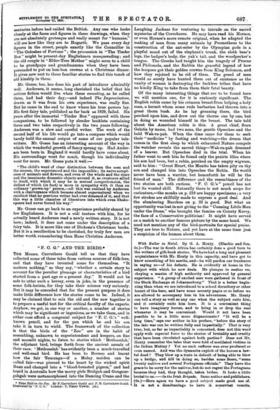GIFT-BOOKS.
HANS CHRISTIAN ANDERSEN.*
IT may seem somewhat late in the day to attempt an apprecia- tion of Hans Christian Andersen, and, indeed, we are not thinking of attempting it. But this most meritorious effort to do justice to the Danish Wizard—surely no man ever more deserved the praise of this name—demands more than a casual recognition. We have seen many editions, even of the complete Fairy Tales, for Andersen died more than a quarter of a century ago, but we do not remember any one so charac- teristic. The book has been translated afresh from the Danish original—many readers have known it through a German medium, and it has lost something in passing through—and it is admirably illustrated by an eminent Danish black-and-white artist. A great amount of time—no less than fifteen years—and of trouble, manifest in every detail, has been spent upon them, and the result is fully adequate. And as Mr. Gosse in his admirable introduction puts it, there is "the fact that everything in them—the landscape, the architecture, the costume, the faces of the human beings—is exclusively and characteristically Danish. "Danish," it must not be forgotten, means something very like " English." It is to them, far more than to the German race, that through our Angle and Jute forefathers we are akin, not to speak of the strong admixture of the direct Danish element that can be traced wherever the rover's from the Baltic raided the English lands just as their kinsmen four • Fairy Tales. By Hans Christian Andersen! Newly .translated by H. L. Eraekstad. With Introduction by Edmund Howe. Illustrated by Hans Tegner. I vols. London ; W. Heinemann. (Ws. net eat:L.J
centuries before had raided the British. Any one who looks closely at the faces and figures in these drawings, when they are not absolutely grotesque and really meant for " humans,"
will see how like they are to Hogarth. We pass every day
figures in the street, people exactly like the Councillor in " The Goloshes of Fortune " ; the procession in " The Tinder Box" might be present-day Englishmen masquerading; and
the old couple in "Elder-Tree Mother" might seem to a child to be grandpapa and grandmamma when they have been
persuaded to put on bon-bon crowns at a Christmas dinner. It gives new zest to these familiar stories to find this touch of old kinship in them.
Mr. Gosse, too, has done his part of introducer admirably well. Andersen, it seems, long cherished the belief that his serious fiction would live when these emoting, as he called them, had had their day,—and indeed The Improvisatore, drawn as it was from his own experience, was really fine. But he came in the end to know where his true powers lay. His first fairy tale, published as far back as 1829, failed. Six years after the immortal " Tinder Box " appeared with three
companions, to be followed by slender booklets containing three and two tales respectively in the two years following. Andersen was a slow and careful writer. The work of the second half of his life would go into a compass which would barely hold the annual output of some of our popular tale- writers. Mr. Gosse has an interesting account of the way in which the wonderful growth of fancy sprang up. Had Ander-
sen been born in England it would hardly have come about. His surroundings went for much, though his individuality went for more. Mr. Gosse puts it well :-- "The child's want of clear distinction between the seen and the unseen, the experienced and the impossible ; its naïve accept- ance of animals and flowers, and even of the winds and the stars and the inanimate domestic objects around it, as creatures allied to itself, with which it may be in mutual comprehension, the dullest of which (in fact) is more in sympathy with it than an ordinary grown-up' person,—all this was realised by Andersen with a clairvoyance which became almost supernatural when we recollect that no previous writer had ever dreamed of it, and that this was a little chamber of literature into which even Shake- speare had never forced his way."
Mr. Gosse can go back to an experience probably shared by few Englishmen. It is not a vidi tantum with him, for he actually heard Andersen read a newly written story. It is not here; indeed, it does not come under the description of a fairy tale. It is more like one of Dickens's Christmas books. But it is a recollection to be cherished, for truly few men are better worth remembering than Hans Christian Andersen.























































 Previous page
Previous page